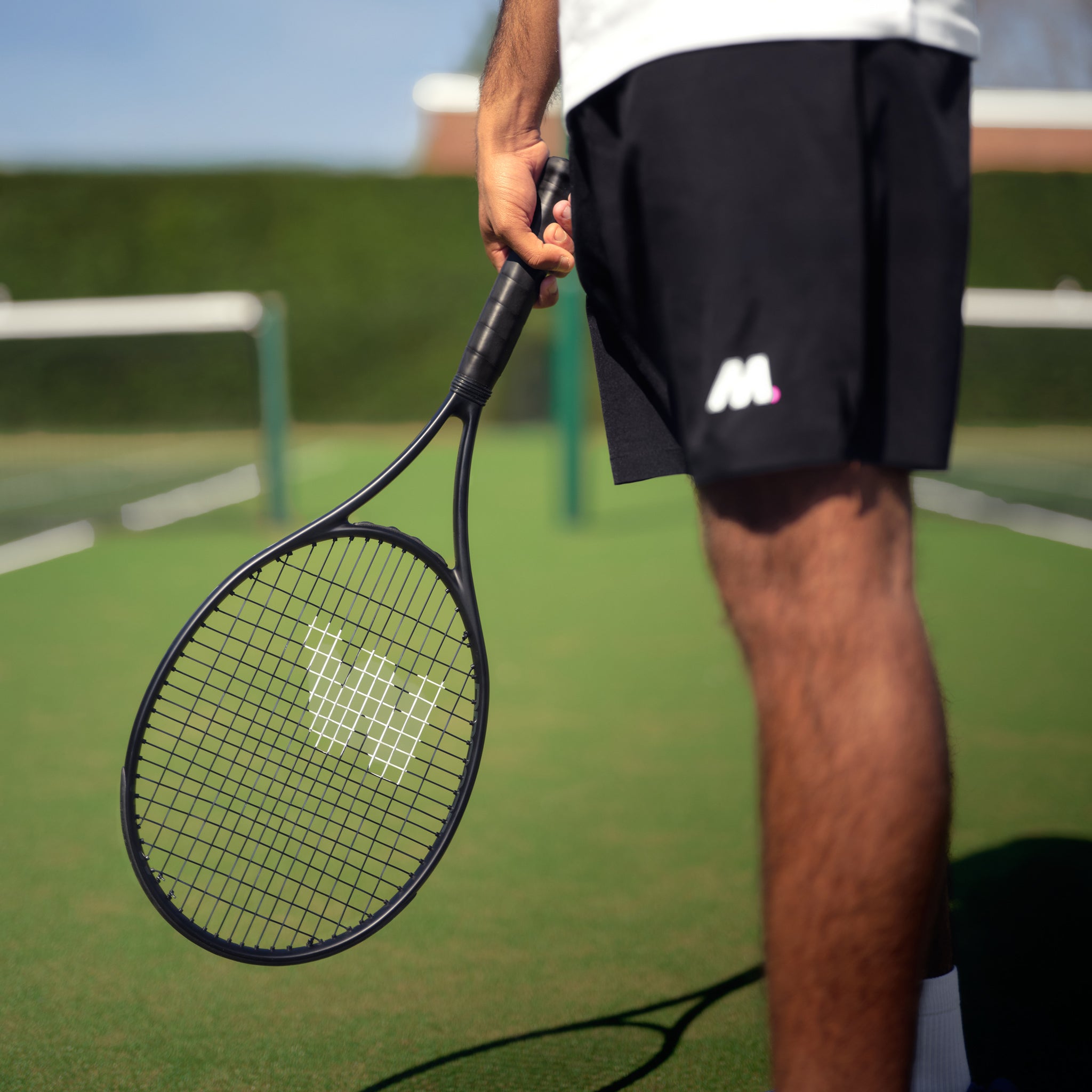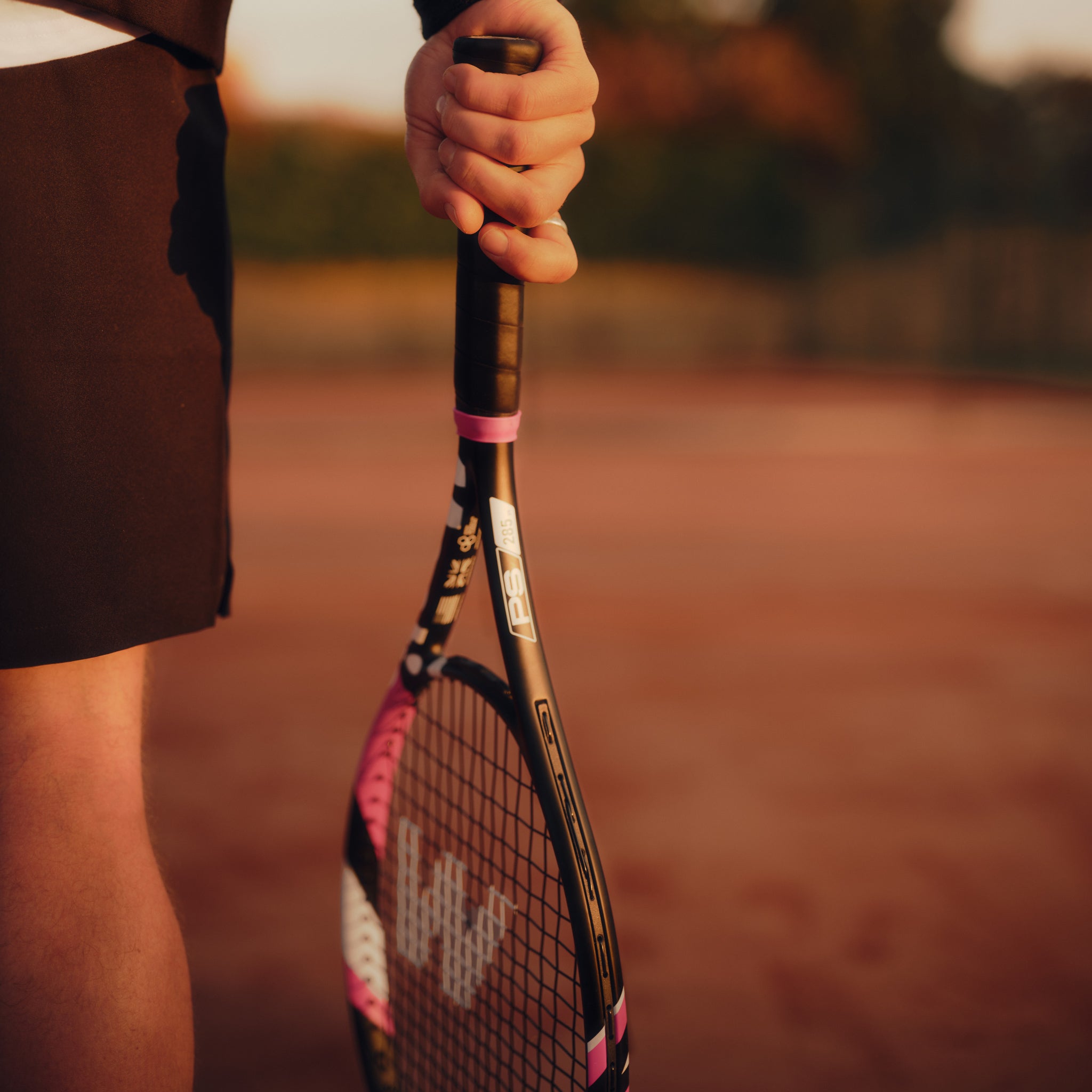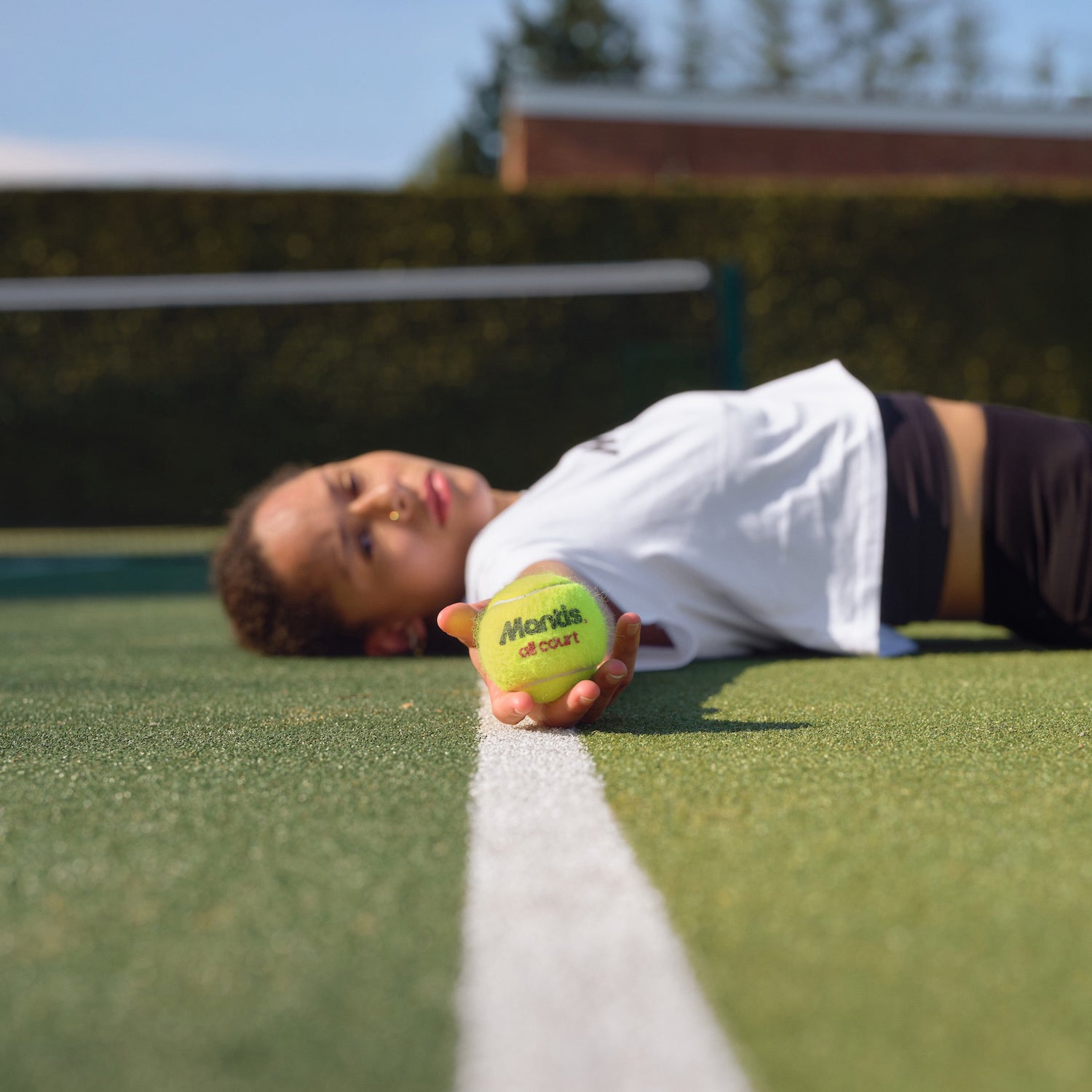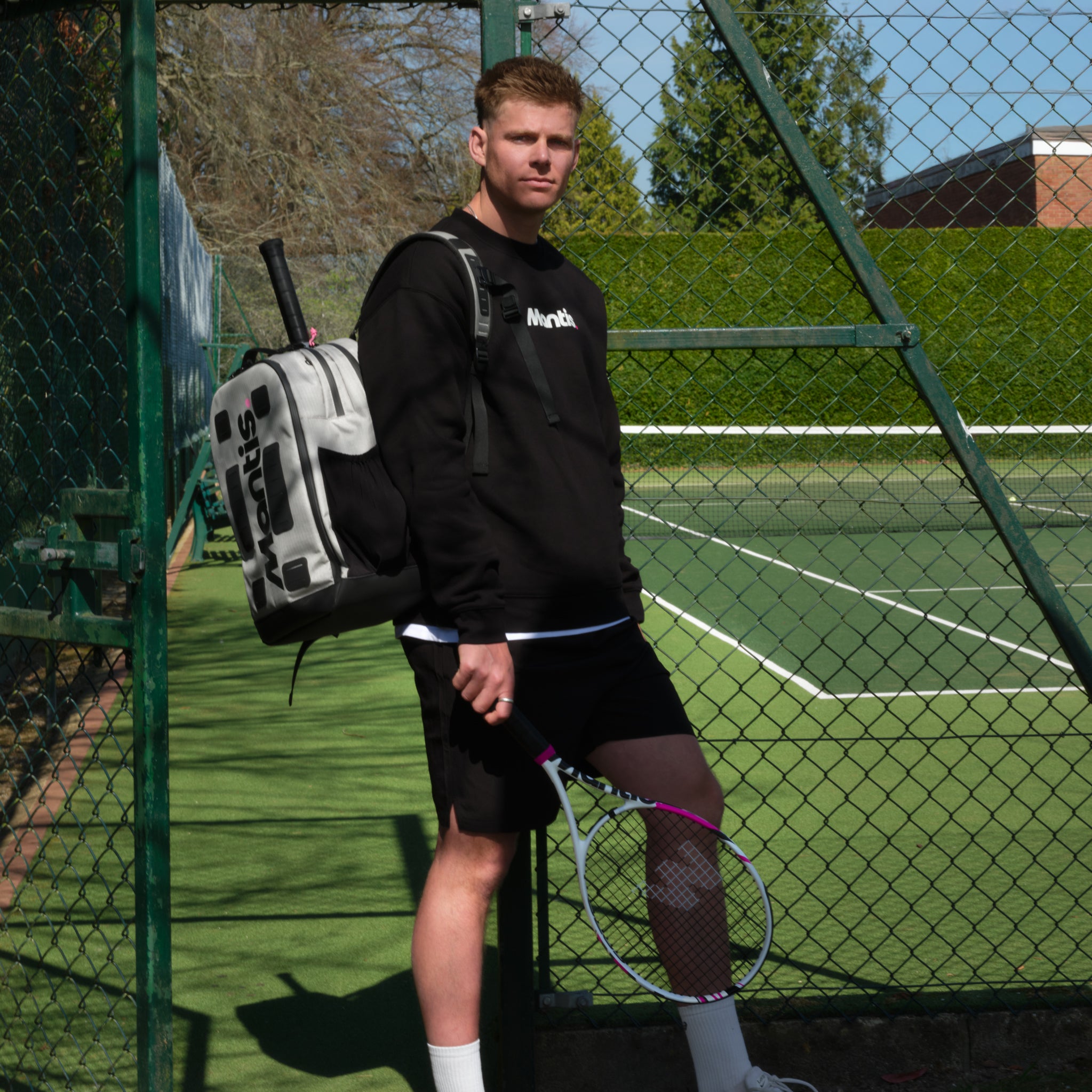
Ever felt that pull to try tennis? You're not alone. The sport has seen a huge surge in popularity recently, making it more accessible and welcoming for newcomers than ever before. This guide to tennis for beginners is your friendly roadmap from the sidelines straight to the baseline.
Why It's a Great Time to Start Playing
If you've been thinking about picking up a racket, you’ve chosen the perfect moment. The old stereotypes of tennis being some exclusive, hard-to-access sport are well and truly fading. Today’s tennis community is far more vibrant, diverse, and genuinely open to beginners.
The numbers don't lie. Recent data from the Lawn Tennis Association (LTA) shows just how much the game has grown. In 2022, the number of adults playing tennis in the UK shot up by a staggering 43%, jumping from 3.3 million to an incredible 4.7 million players in just one year. This isn't just a statistic; it points to a thriving, welcoming environment that’s perfect for anyone looking to learn.
More Than Just a Game
Beyond the boom in popularity, tennis offers a fantastic mix of physical and mental benefits. It's not just about whacking a ball over a net—it’s a full-body workout that sharpens your coordination, agility, and cardiovascular health. Our goal with this guide is simple: to get you past that "I don't know where to start" feeling and onto the court with confidence.
Here’s a little taste of what you can look forward to as a new player:
- A Great Social Outlet: Joining local clubs or just playing at public courts is a brilliant way to meet new people.
- Stress Relief: Honestly, there's nothing quite like the feeling of hitting a clean forehand after a long week. It's a fantastic way to clear your head.
- A Lifelong Sport: Tennis is one of those rare games you can play and enjoy at any age, from childhood right through to your retirement years.
Tennis is one of the most gender-balanced sports in the country, with women making up 41% of all adult players in the UK. This helps create a more inclusive and welcoming atmosphere at clubs and courts nationwide.
Together, we'll walk through everything a beginner needs to know. We're talking about choosing a racket that feels right in your hand, understanding the court, mastering your first real shots, and even playing a simple game. Let's get you ready to enjoy every single rally.
Choosing Your First Tennis Gear
Walking into a sports shop for the first time can feel like a lot to take in. Rackets, balls, shoes... where do you even start? The good news is, gearing up for tennis doesn't have to be complicated or break the bank.
Let's cut through the noise and focus on what you actually need to get started on the right foot, making sure you buy with confidence and don’t waste money on gear that won’t help you.
The most important piece of your kit, without a doubt, is the racket. It’s a classic beginner mistake to grab a flashy, professional-looking model off the wall. In reality, the best rackets for newcomers are designed with one thing in mind: forgiveness. They help you make solid, clean contact with the ball more often as you’re just getting the hang of your swing.
As you can see, a bigger racket face gives you a much larger "sweet spot." This makes it far easier to connect with the ball properly, which is a massive confidence booster when you're learning.
Finding The Right Beginner Racket
When you’re picking out that first racket, don’t let the technical jargon throw you off. There are really only a few key things you need to pay attention to.
To make it even simpler, here's a quick guide to help you compare your options at a glance.
Beginner Racket Selection Guide
| Feature | What to Look For | Why It Matters for a Beginner |
|---|---|---|
| Head Size | 100+ square inches (Oversize) | A bigger surface area gives you more room for error, helping you hit clean shots. |
| Weight | Under 300 grams (Lightweight) | Easier to swing and control, which prevents fatigue and helps you learn proper form. |
| Grip Size | A comfortable fit | The right size prevents you from gripping too tightly and reduces the risk of injury. |
Choosing a racket that fits these criteria will set you up for success and make your first few months on the court much more enjoyable.
A common pitfall for new players is buying a racket that's too heavy or has the wrong grip size. I’ve seen it countless times. It not only makes learning the fundamentals much harder but can also lead to nasty injuries like tennis elbow or wrist strain down the line. To get this right, you can learn more about how to choose a tennis racket in our detailed guide.
Don't Forget The Balls And Shoes
With your racket sorted, what about the rest?
Next up are the tennis balls themselves. You’ll probably see two main types on the shelf: pressurised and pressureless. For your practice sessions, pressureless balls are a fantastic choice. They keep their bounce for much longer and tend to fly a bit slower and more predictably. This gives you that extra split-second to get into position and prepare your shot.
Finally, let's talk about your feet. It's so tempting to just grab any old pair of trainers from your wardrobe, but proper tennis shoes are a game-changer. They’re specifically built to handle the sharp, side-to-side movements that define the sport.
This lateral support is crucial for protecting your ankles and knees from twists and sprains. While tennis shoes have unique features, understanding the basics of how to buy athletic shoes the right way is a great starting point. Trust us, investing in a decent pair is one of the smartest moves you can make for both your safety and your game.
Tennis for Beginners: Learning the Fundamental Strokes and Grips
Alright, this is where the real fun begins—actually hitting the ball. We're going to break down the most important shots without getting lost in technical jargon. And it all starts with the way you hold the racket.
A solid grip is the foundation for every single shot you'll ever hit. Think of it like learning to hold a pencil properly before you start writing; get this right, and you're setting yourself up for control, power, and consistency down the road.
Honestly, how you hold the racket directly impacts the angle of the racket face when it meets the ball. This one thing determines whether your shot sails perfectly over the net, dives straight into it, or flies frustratingly out of bounds.
Your First Two Essential Grips
For a beginner, we can cut through the noise and simplify the world of grips down to just two to get you started. To find them, it helps to imagine the handle of your racket has eight sides, or "bevels". With the racket on its edge, the flat part on top is bevel #1, and they count clockwise from there (for a right-handed player).
-
The Continental Grip (or "Hammer Grip"): This is your ultimate multi-tool. To find it, just hold the racket as if you were shaking hands with it, or holding a hammer. The base knuckle of your index finger should rest on bevel #2. It’s the go-to grip for serves, volleys, and overheads.
-
The Eastern Forehand Grip: This is the classic, beginner-friendly grip for your forehand. From the Continental grip, simply rotate your hand one bevel clockwise so your index knuckle lands on bevel #3. It’s a really natural position that makes hitting a flat, reliable forehand much easier.
Pro Tip: Don't strangle the racket! A classic beginner mistake is the "death grip," which kills your swing and tires your arm out fast. Aim for a firm but relaxed hold. We always tell new players to hold it like a small bird—firm enough so it can’t escape, but gentle enough not to hurt it.
For a more detailed look with some great pictures, our complete guide on how to grip a tennis racket is the perfect next step. It’ll help you nail this crucial element from day one.
Mastering The Four Foundational Strokes
Once you feel comfortable holding the racket, it’s time to build the four strokes that form the backbone of any tennis player's game. The key at this stage is to focus on a simple, repeatable motion, not brute force.
The Forehand
The forehand is usually the first shot that clicks for new players because it feels the most natural. You hit it on your dominant side after the ball has bounced once.
Your swing should be a smooth, flowing movement. Start by turning your shoulders and hips as you take the racket back to about waist height. As the ball comes to you, swing forward in a "low-to-high" path. You want to make contact in front of your body and let the racket follow through naturally over your opposite shoulder.
The Backhand
The backhand is simply the stroke you hit on your non-dominant side. For anyone starting out, we always recommend the two-handed backhand. It just gives you more stability and power when you're still developing strength.
You’ll have both hands on the racket. Your dominant hand uses a Continental grip at the bottom, and your non-dominant hand goes above it in an Eastern-style grip. The motion is the same idea as the forehand: turn your body, swing from low to high, and really let your non-dominant arm guide the shot. The one-hander can come later, but starting with two builds a fantastic foundation.
The Volley
A volley is any shot you hit before the ball bounces, typically when you’re up close to the net. There’s almost no backswing here—it’s more of a firm punch or a block.
Use that all-purpose Continental grip for both forehand and backhand volleys. The key is to keep your racket up and in front of you, stay light on your feet, and meet the ball out in front with a short, crisp motion.
The Serve
The serve starts every single point. It can look intimidating, but your first goal is simply consistency—just getting it in.
Using your Continental grip, the basic motion feels a lot like throwing a ball over your head. Stand with your feet about shoulder-width apart, toss the ball up consistently to a point just above your head, and reach up to hit it at the very top of its arc. Forget about power for now. Just focus on a smooth, coordinated movement that sends the ball into the correct service box.
Right, let's talk about scoring. At first, the scoring system in tennis can feel a bit like trying to learn a new language. But we promise you, once you get the hang of it, it’s actually pretty straightforward and adds a fantastic layer of strategy to every match.
This is your cheat sheet to feeling confident on the court, from knowing the lines to calling out the score like you’ve been doing it for years.
First, a quick tour of your new playground. That line at the very back of the court? That's the baseline. Up closer to the net, you'll see two smaller boxes on each side – those are the service boxes, and they're your target when you serve. The narrow lanes running down the sides are the alleys, which only count as 'in' during a doubles match. Simple.
How Tennis Scoring Really Works
Now for those funny numbers. Tennis is built on points, which make up games, which in turn make up sets. To win a match, you usually need to win two out of three sets. In some professional men's matches, it's a marathon three out of five.
Here’s how it breaks down:
- Points: This is the smallest unit. The score doesn't go 1, 2, 3. Instead, it’s love (that's zero), then 15, then 30, and finally 40. If you're on 40 and win the next point, you've won the game.
- Games: To win a game, you need to win at least four points. Crucially, you have to win by a margin of two. If the score gets to 40-40, it’s called deuce. More on that in a moment.
- Sets: A set goes to the first player to win six games, but again, you must win by at least two games. So, a 6-4 score wins the set. If it's 6-5, you play on.
Deuce is a term every new player needs to get comfortable with. When the score hits 40-40, one player has to win two points in a row to take the game. If you win the first point from deuce, you get the Advantage (we say 'Ad-In' if you're serving, 'Ad-Out' if you're receiving). Win the next point, and the game is yours. Lose it, and the score snaps right back to deuce.
The Key Rules You’ll Bump Into Straight Away
Knowing the score is only half the battle. A few fundamental rules will pop up in almost every point, right from your very first rally.
When you serve, the ball has to land diagonally opposite in the correct service box without touching the net. You always get two attempts. Miss the first, and it's a fault. Miss the second one as well, and that’s a double fault – you lose the point on the spot.
Another massive part of the game is judging if a ball is 'in' or 'out'. Here's the golden rule: a ball that lands on any part of the line is considered in. In friendly games without an umpire, you're responsible for the calls on your side of the net. Honesty and clear, confident calls are what keep the game fun and fair for everyone.
Simple Drills to Build Your Confidence
Reading about technique is one thing, but consistent practice is where the real magic happens. This is where theory hits the court and you start to see genuine improvement.
We're going to share a few simple, highly effective drills that I used myself when I was starting out. You can do them with a partner or even on your own. The goal here isn’t perfection straight away. It’s all about building that crucial muscle memory and getting a feel for the racket connecting with the ball. These drills are designed to be productive and, just as importantly, fun.
Starting with Hand-Eye Coordination
Before you even dream of hitting a rally, we need to build the most fundamental connection: your hand, the racket, and the ball. This is ground zero for developing your "feel" on the court.
- Racket Bounces: Just start by bouncing the ball straight up and down on your racket strings. Try to keep it in the centre. First, aim for 10 bounces in a row. Once you’ve got that down, try alternating between your forehand and backhand sides.
- Walk and Bounce: Feeling comfortable? Now, try walking slowly forward while keeping the bounces going. This introduces a bit of movement and forces you to make micro-adjustments to stay in control.
These might feel a bit basic, but trust us, they are incredibly powerful for programming the hand-eye coordination that every single tennis stroke relies on.
A quick tip from experience: The aim is control, not height. A small, controlled bounce is far more beneficial than sending the ball flying into the air. It teaches you to absorb and redirect energy—a key skill for every shot you'll ever hit.
Mastering Control with Mini Tennis
Alright, let's get you on the court. But we aren't heading straight to the baseline just yet. We're going to start with "mini tennis," a fantastic drill for developing control over your forehand and backhand from a much shorter distance.
Find a practice partner and stand just inside your own service line, with them in the same spot on the other side. The goal is simple: rally back and forth, trying to keep the ball landing inside the service boxes.
Use a soft, easy swing. This is all about placement, not power. Focus on that low-to-high swing path we talked about earlier and see how long you can keep the rally going. This drill is brilliant for learning how to direct the ball and getting used to the timing of a moving target. If you’re practising alone, a practice wall or even the side of a building works perfectly for this.
Building a Consistent Serve
For any beginner, a reliable serve is a massive confidence booster. Forget about hitting aces for now. Our only goal with this drill is to develop a smooth, repeatable motion and consistently get the ball in the correct service box.
Here’s how to build it up gradually:
- Start Close: Don't start at the baseline. Stand on the service line instead. This immediately shortens the distance and makes success feel much more achievable.
- Focus on Motion: Think of it like an easy throwing motion. Toss the ball gently in front of you and just focus on making clean contact, guiding the ball over the net.
- Aim for the Box: Don’t worry about hitting the corners. Your target is the entire diagonal service box. Aim for the biggest target you have.
- Take a Step Back: Once you can consistently land 5 out of 10 serves in from the service line, take a few steps back towards the baseline and do it all again.
This step-by-step approach takes the pressure off and helps you build a solid serve from the ground up. This method is especially effective for younger players, which is a huge focus in the UK. The LTA’s Youth Programme has supported the training of over 10,000 teachers to deliver tennis, which helped bring 418,000 new child players into the sport in 2022 alone.
Common Questions From New Tennis Players
Every new player has questions, and you're not alone. We’ve seen it time and time again: starting a sport like tennis feels like there's a mountain of things to learn all at once, from the gear to the rules. So let's clear up a few of the most common queries we hear on the court.
Our goal here is to help you get through those early days with a bit more confidence and a lot less confusion. We’ll talk about practice schedules, whether lessons are really worth it, and what to do when you feel stuck in a rut.
How Often Should I Practise?
When you’re just starting, consistency beats intensity every single time. Honestly, just getting out on the court once a week is a fantastic starting point. A regular weekly session gives you enough time to absorb what you’re learning without feeling overwhelmed or burning yourself out.
Once you start feeling more comfortable, you could think about adding a second, shorter hit. This doesn't have to be another full-on match. It could be as simple as spending 30 minutes against a practice wall. That repetition is what builds muscle memory and makes your progress feel real. Don't underestimate the value of short, focused practice.
Are Tennis Lessons Worth It?
Look, you can absolutely teach yourself the basics. But if you’re serious about improving, investing in a few lessons with a qualified coach can fast-track your progress like nothing else. A good coach will spot and fix bad habits before they become second nature—and trust me, unlearning those is much harder down the line.
A coach gives you personalised feedback that a YouTube tutorial just can't match. They can tailor drills to your game, whether it’s sorting out your grip or building a more reliable serve. Even one or two lessons can lead to a breakthrough.
Many new players find that group lessons are a great middle-ground. They're more affordable than private coaching and put you in a fun, social setting with other beginners who are in the exact same boat.
What If I'm Not Improving?
Hitting a plateau is a completely normal part of learning any skill, and tennis is no exception. We've all been there. If you feel like your progress has stalled, it might be time to shake things up a bit. Instead of just rallying from the baseline again, try focusing on a different part of your game, like footwork drills or volleys at the net.
Sometimes, the best move is to step away and try something different altogether. A lot of tennis players are finding that other racket sports can actually help their game in unexpected ways. For instance, padel has absolutely exploded in Britain as a fun, beginner-friendly activity. The latest figures show the number of adults playing padel twice a month doubled to 51,000 in the past year, with over 400,000 people having tried it. You can discover more about the growth of padel in Britain on the official LTA Padel site. A different sport can refresh your mind and sharpen your racket skills in ways you didn't see coming.
At Mantis, we believe in performance without pretension. Our expertly crafted rackets, balls, and gear are designed with one purpose: to help you progress. We obsess over every detail so you can focus on your game. Shop our collection today and feel the difference on the court.








